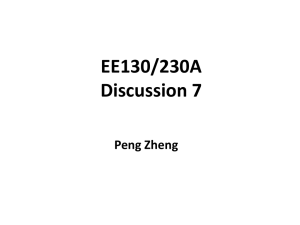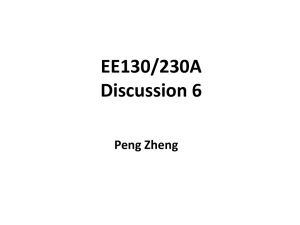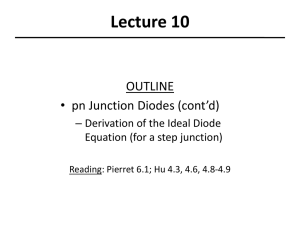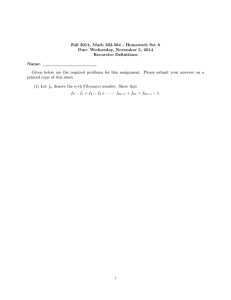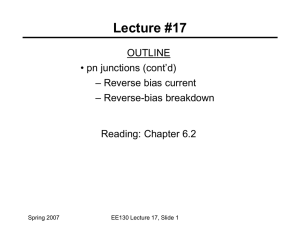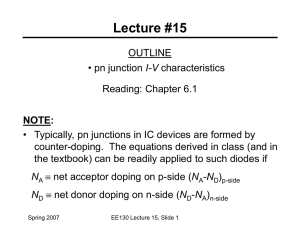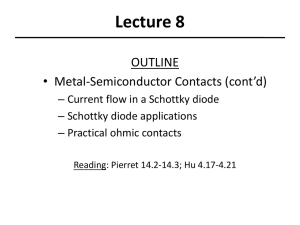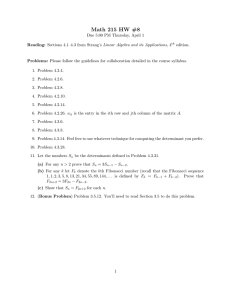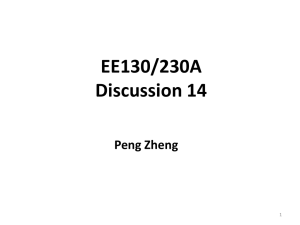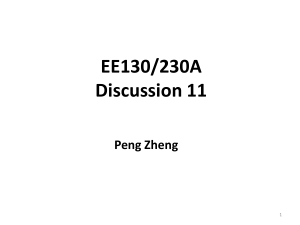Lecture 11 OUTLINE • pn Junction Diodes (cont’d) – Narrow-base diode
advertisement
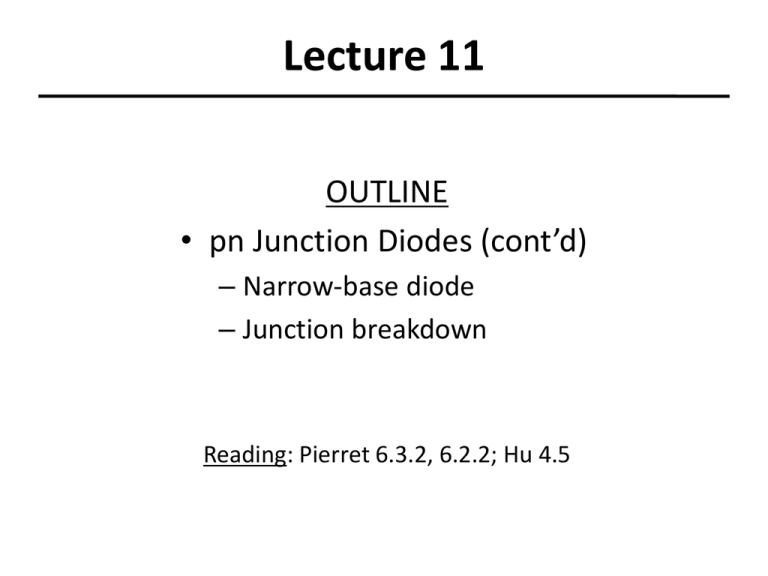
Lecture 11 OUTLINE • pn Junction Diodes (cont’d) – Narrow-base diode – Junction breakdown Reading: Pierret 6.3.2, 6.2.2; Hu 4.5 Introduction • The ideal diode equation was derived assuming that the lengths of the quasi-neutral p-type & n-type regions (WP’ , WN’) are much greater than the minority-carrier diffusion lengths (Ln , Lp) in these regions. Excess carrier concentrations decay exponentially to 0. Minority carrier diffusion currents decay exponentially to 0. • In modern IC devices, however, it is common for one side of a pn junction to be shorter than the minority-carrier diffusion length, so that a significant fraction of the “injected” minority carriers reach the end of the quasi-neutral region, at the metal contact. Recall that Dp = Dn = 0 at an ohmic contact In this lecture we re-derive the diode I-V equation with the boundary condition that Dp = 0 at a distance xc’ (rather than ) from the edge of the depletion region. EE130/230A Fall 2013 Lecture 11, Slide 2 Excess Carrier Distribution (n side) 2 d • From the minority carrier diffusion equation: Dpn Dpn Dp2n dx 2 Dp p Lp • For convenience, let’s use the coordinate system: x’’ 0 0 x’ xc' • So the solution is of the form: Dpn ( x' ) A1e x '/ L p A2e • We have the following boundary conditions: Dpn ( x' 0) pno (e qVA / kT 1) EE130/230A Fall 2013 Lecture 11, Slide 3 Dpn ( x' xc ' ) 0 x '/ L p • Applying the boundary conditions, we have: Dpn (0) A1 A2 pno (e qVA / kT 1) • Therefore Dpn ( x ) A1e ' c xc' / L p A2 e xc' / L p 0 e xc x ' / LP e xc x ' / LP 1) e xc' / LP e xc' / LP ' Dpn ( x' ) pn 0 (e • Since qVA / kT sinh Dpn ( x' ) pn 0 (e e e 2 qVA / kT ' , 0 x' xc' this can be rewritten as sinh xc' x' / LP 1) ' sinh x c / LP , 0 x' x • We need to take the derivative of Dpn’ to obtain the hole diffusion current within the quasi-neutral n region: EE130/230A Fall 2013 Lecture 11, Slide 4 ' c Dpn ( x) J P qD p x 1 coshxc x / LP LP qVA / kT J p qD p pn 0 e 1 sinh xc / LP e e where cosh 2 Evaluate Jp at x=xn (x’=0) to find the injected hole current: D n2 cosh x / L Jp x 0 q p i LP N D (e qVA kT 1) c P sinh xc / LP Thus, for a one-sided p+n junction (in which the current is dominated by injection of holes into the n-side) with a short n-side: I I 0 (e qV A kT EE130/230A Fall 2013 1) where I qA ' 0 Lecture 11, Slide 5 DP ni 2 cosh xc' / LP LP N D sinh xc' / LP sinh as 0 and cosh 1 2 as 0 Therefore if xc’ << LP: 2 cosh xc / LP 1 xc / LP LP xc / LP sinh xc / LP xc For a one-sided p+n junction, then: D p ni2 I 0 qA LP N D EE130/230A Fall 2013 D p ni2 LP qA xc N D xc Lecture 11, Slide 6 Excess Hole Concentration Profile If xc’ << LP: Dpn ( x' ) pn 0 (e p n 0 (e qVA / kT qVA / kT sinh xc' x' / LP 1) ' sinh x c / LP xc' x' / LP x' qVA / kT pn 0 (e 1) 1)1 ' ' xc / LP xc Dpn is a linear function: pno (e qVA / kT Dpn(x) 1) 0 Jp is constant 0 slope is constant x'c x' (No holes are lost due to recombination as they diffuse to the metal contact.) EE130/230A Fall 2013 Lecture 11, Slide 7 General Narrow-Base Diode I-V • Define WP‘ and WN’ to be the widths of the quasi-neutral regions. • If both sides of a pn junction are narrow (i.e. much shorter than the minority carrier diffusion lengths in the respective regions): DP DN qVA / kT qVA / kT I qAni e 1 I0 e 1 WN N D WP N A 2 e.g. if hole injection J into the n side is greater than electron injection JN into the p side: JP -xp EE130/230A Fall 2013 Lecture 11, Slide 8 xn x Summary: Narrow-Base Diode • If the length of the quasi-neutral region is much shorter than the minority-carrier diffusion length, then there will be negligible recombination within the quasi-neutral region and hence all of the injected minority carriers will “survive” to reach the metal contact. – The excess carrier concentration is a linear function of distance. For example, within a narrow n-type quasi-neutral region: pno (e qVA / kT Dpn(x) 1) 0 xn location of metal contact (Dpn=0) x WN’ The minority-carrier diffusion current is constant within the narrow quasi-neutral region. Shorter quasi-neutral region steeper concentration gradient higher diffusion current EE130/230A Fall 2013 Lecture 11, Slide 9 pn Junction Breakdown C. C. Hu, Modern Semiconductor Devices for Integrated Circuits, Figure 4-10 Breakdown voltage, VBR VA A Zener diode is designed to operate in the breakdown mode: EE130/230A Fall 2013 Lecture 11, Slide 10 Review: Peak E-Field in a pn Junction E(x) dx Si (0) qN A x p Si -xp qN D xn Si 2qVbi VA N A N D Si N A ND xn E(0) For a one-sided junction, (0) 2qVbi VA N Si where N is the dopant concentration on the lightly doped side EE130/230A Fall 2013 Lecture 11, Slide 11 x Breakdown Voltage, VBR • If the reverse bias voltage (-VA) is so large that the peak electric field exceeds a critical value ECR, then the junction will “break down” (i.e. large reverse current will flow) CR 2qN Vbi VBR s • Thus, the reverse bias at which breakdown occurs is VBR EE130/230A Fall 2013 s CR 2qN 2 Vbi Lecture 11, Slide 12 Avalanche Breakdown Mechanism R. F. Pierret, Semiconductor Device Fundamentals, Figure 6.12 High E-field: VBR s CR 2qN 2 if VBR >> Vbi Low E-field: ECR increases slightly with N: For 1014 cm-3 < N < 1018 cm-3, 105 V/cm < ECR < 106 V/cm EE130/230A Fall 2013 Lecture 11, Slide 13 Tunneling (Zener) Breakdown Mechanism Dominant breakdown mechanism when both sides of a junction are very heavily doped. VA = 0 VA < 0 Ec Ev VBR CR s CR 2qN 2 Vbi 106 V/cm Typically, VBR < 5 V for Zener breakdown EE130/230A Fall 2013 Lecture 11, Slide 14 C. C. Hu, Modern Semiconductor Devices for Integrated Circuits, Figure 4-12 Empirical Observations of VBR R. F. Pierret, Semiconductor Device Fundamentals, Figure 6.11 • VBR decreases with increasing N • VBR decreases with decreasing EG EE130/230A Fall 2013 Lecture 11, Slide 15 VBR Temperature Dependence • For the avalanche mechanism: – VBR increases with increasing T, because the mean free path decreases • For the tunneling mechanism: – VBR decreases with increasing T, because the flux of valence-band electrons available for tunneling increases EE130/230A Fall 2013 Lecture 11, Slide 16 Summary: Junction Breakdown • If the peak electric field in the depletion region exceeds a critical value ECR, then large reverse current will flow. This occurs at a negative bias voltage called the breakdown voltage, VBR: VBR s CR 2qN 2 Vbi where N is the dopant concentration on the more lightly doped side • The dominant breakdown mechanism is avalanche, if N < ~1018/cm3 tunneling, if N > ~1018/cm3 EE130/230A Fall 2013 Lecture 11, Slide 17
